Climate Variability, Land Cover Changes and Livelihoods of Communities on the Fringes of Bobiri Forest Reserve, Ghana
Abstract
1. Introduction
2. Materials and Methods
2.1. Description of Study Area
2.2. Research Design and Analysis
2.2.1. Trend Analysis of Rainfall and Temperature
2.2.2. Image Acquisition
2.2.3. Image Preprocessing
2.2.4. Image Classification
Unsupervised Classification
Field Data Collection
Supervised Classification
2.2.5. Change Detection
2.2.6. Validation
2.2.7. Participatory Methods
3. Results
3.1. Sociodemographic Characteristics of the Respondents
3.2. Main Livelihood Activities of the Communities
3.3. Perception of the Respondents on Rainfall and Temperature Changes
3.4. Extent of Rainfall and Temperature Changes in the Bobiri Forest Reserve, Ghana
3.5. Description of Landsat Images from 1986, 2003, 2010 and 2014
3.6. LULC Changes 1986–2014
3.7. Land Use and Distribution Cover
3.8. Accuracy Assessment
3.9. Perceived Factors Driving LULC Changes in the Bobiri Forest Reserve
“Most of the indigenes cut down trees for the production of charcoal and firewood, and also the trees provide us with construction materials which we sell to generate income for ourselves and families, and I think it could be a crucial factor for LULC changes.”(Focus group participant, Kubease, April, 2017).
“Some of the farmers engage in shifting cultivation and the moment the new forested lands they are cultivating on get engulfed by weeds, then they move to clear more forests which in my opinion could be a cause of LULC.”(Focus group participant, Konfradae, May, 2017).
“Because our population is higher now as compared to the past, people have moved to settle here and as a result have cut down trees and have built houses on the land and in my opinion this could be a driving factor of LULC.”(Focus group participant, Dwabenymma, May, 2017).
“In my opinion, I think the decreased amounts of rainfall and the increasing temperatures have caused some of the trees to die and this could be the reason for the conversion of the closed forest to other land cover types such as grassland.”(Key informant, Krofofrom, April, 2017).
“Because the rains are inconsistent as in the past where there were increased amounts of rainfall, most of the plants are getting destroyed because of the increasing temperatures and this in my opinion could be the major reason for the conversion of the undisturbed forest into grassland and other land cover types.”(Key informant, Kubease, April, 2017).
“The heat we experience these days does not favour the growth of many of the trees in the forest reserve. For instance, the drought we experienced in this country from 1981–1983 caused numerous trees to die because of the absence of the rains for almost two years. Personally, I believe that is the reason for the decrease in the closed forest.”(Key informant, Dwabenymma, April, 2017).
4. Discussion
4.1. Perception of Fringe Communities on Rainfall and Temperature Changes
4.2. Extent of Rainfall and Temperature Changes in the Study Communities
4.3. Extent of LULC Changes in the Bobiri Forest Reserve over the Study Period
4.4. Perceived Factors Driving LULC Changes in the Bobiri Forest Reserve, Ghana
4.5. Perceived Role of Climate Variability in Driving Land Cover Changes in Bobiri Forest Reserve
5. Conclusions and Recommendations
Author Contributions
Funding
Acknowledgments
Conflicts of Interest
Appendix A
| Variables | Gender | ||
|---|---|---|---|
| Males (n = 143) | Females (n = 257) | Total (n = 400) | |
| Age (years) | |||
| Below 20 | 8 (5.6) | 20 (7.8) | 28 (7.0) |
| 21–40 | 92 (64.3) | 125 (48.6) | 217 (54.3) |
| 41–60 | 20 (14.0) | 68 (26.5) | 88 (22.0) |
| >60 | 23 (16.1) | 44 (17.1) | 67 (16.8) |
| Education | |||
| No formal education | 32 (22.4) | 25 (9.7) | 57 (14.3) |
| Basic | 61 (42.6) | 203 (79.0) | 264 (66.0) |
| Secondary | 28 (19.6) | 15 (5.8) | 43 (10.7) |
| Tertiary | 22 (15.4) | 14 (5.5) | 36 (9.0) |
| Household size | |||
| 1 to 5 Individuals | 101 (70.6) | 125 (48.6) | 226 (56.5) |
| 6 to 10 Individuals | 38 (26.6) | 100 (38.9) | 138 (34.5) |
| 11 to 15 Individuals | 4 (2.8) | 32 (12.5) | 36 (9.0) |
| Length of farming experience (in years) | |||
| <5 | 15 (10.5) | 38 (14.8) | 53 (13.3) |
| 6–10 | 67 (46.9) | 89 (34.6) | 156 (39.0) |
| 11–20 | 33 (23.1) | 77 (30.0) | 110 (27.5) |
| >20 | 28 (19.5) | 53 (20.6) | 81 (20.3) |
References
- Niang, I.; Ruppel, O.C.; Abdrabo, M.A.; Essel, A.; Lennard, C.; Padgham, J.; Urquhart, P.A. Climate Change 2014: Impacts, Adaptation and Vulnerability—Contributions of the Working Group II to the Fifth Assessment Report of the Intergovernmental Panel on Climate Change; Cambridge University Press: Cambridge, UK, 2014; pp. 1199–1265. [Google Scholar] [CrossRef]
- Intergovernmental Panel on Climate Change. Synthesis Report Summary Chapter for Policymakers; IPCC: Genevavgbcf, Switzerland, 2014. [Google Scholar]
- Keenan, R.J. Climate change impacts and adaptation in forest management: A review. Ann. For. Sci. 2015, 72, 145–167. [Google Scholar] [CrossRef]
- Lucier, A.; Ayres, M.; Karnosky, D.; Thompson, I.; Loehle, C.; Percy, K.; Sohngen, B. Forest responses and vulnerabilities to recent climate change. IUFRO World Ser. 2009, 22, 29–52. [Google Scholar]
- Lenoir, J.; Gégout, J.C.; Dupouey, J.L.; Bert, D.; Svenning, J.C. Forest plant community changes during 1989–2007 in response to climate warming in the Jura Mountains (France and Switzerland). J. Veg. Sci. 2010, 21, 949–964. [Google Scholar] [CrossRef]
- Allen, C.D.; Macalady, A.K.; Chenchouni, H.; Bachelet, D.; McDowell, N.; Vennetier, M.; Kitzberger, T.; Rigling, A.; Breshears, D.D.; Hogg, E.H.; et al. A global overview of drought and heat-induced tree mortality reveals emerging climate change risks for forests. For. Ecol. Manag. 2010, 259, 660–684. [Google Scholar] [CrossRef]
- Akudugu, M.A.; Dittoh, S.; Mahama, E.S. The implications of climate change on food security and rural livelihoods: Experiences from Northern Ghana. J. Environ. Earth Sci. 2012, 2, 21–29. [Google Scholar]
- Derbile, E.K. Reducing vulnerability of rain-fed agriculture to drought through indigenous knowledge systems in north-eastern Ghana. Int. J. Clim. Chang. Strateg. Manag. 2013, 5, 71–94. [Google Scholar] [CrossRef]
- Yaro, J.A. Building Resilience and Reducing Vulnerability to Climate Change: Implications for Food Security in Ghana; Friedrich-Ebert-Stiftung, Ghana Office: Accra, Ghana, 2013. [Google Scholar]
- Kofi, A.F.; Joyce, A.; Rose, A.D.; Mensah, A.K.; Samuel, A.; Agyei, B.E.; Nyarko, O.A.; Minu, P. The Potential and Constraints of Agroforestry in Forest Fringe Communities of the Asunafo District-Ghana; Friedrich-Ebert-Stiftung, Ghana Office: Accra, Ghana, 2003. [Google Scholar]
- Somarriba, E. Revisiting the past: An essay on agroforestry definition. Agrofor. Syst. 1992, 3, 233–240. [Google Scholar] [CrossRef]
- Amisah, S.; Gyampoh, A.B.; Sarfo-Mensah, P.; Quagrainie, K.K. Livelihood trends in response to climate change in forest fringe communities of the Offin Basin in Ghana. J. Appl. Sci. Environ. Manag. 2009, 13, 13. [Google Scholar] [CrossRef][Green Version]
- Mckeown, J.P.; Gyakye, J.K. Promoting Legal Livelihoods in Ghana; Tropenbos International: Wageningen, The Netherlands, 2015. [Google Scholar]
- Antwi-Agyei, P.; Kpenekuu, F.; Hogarh, J.N.; Obiri-Danso, K.; Abaidoo, R.C.; Jeppesen, E.; Andersen, M.N. Land use and land cover changes in the owabi reservoir catchment, Ghana: Implications for livelihoods and management. Geosciences 2019, 9, 286. [Google Scholar] [CrossRef]
- Boakye, E.; Odai, S.N.; Adjei, K.A.; Annor, F.O. Landsat images for assessment of the impact of land use and land cover changes on the Barekese catchment in Ghana. Eur. J. Sci. Res. 2008, 22, 269–278. [Google Scholar]
- Damnyag, L.; Saastamoinen, O.; Blay, D.; Dwomoh, F.K.; Anglaaere, L.C.; Pappinen, A. Sustaining protected areas: Identifying and controlling deforestation and forest degradation drivers in the Ankasa Conservation Area, Ghana. Biol. Conserv. 2013, 165, 86–94. [Google Scholar] [CrossRef]
- Forestry Research Institute of Ghana (FORIG). 2011. Available online: http://csir-forig.org.gh/ (accessed on 4 March 2020).
- Addo-Fordjour, P.; Ankomah, F. Patterns and drivers of forest land cover changes in tropical semi-deciduous forests in Ghana. J. Land Use Sci. 2017, 12, 71–86. [Google Scholar] [CrossRef]
- Osei, M.A.; Amekudzi, L.K.; Wemegah, D.D.; Preko, K.; Gyawu, E.S.; Obiri-Danso, K. The impact of climate and land-use changes on the hydrological processes of Owabi catchment from SWAT analysis. J. Hydrol. Reg. Stud. 2019, 25, 100620. [Google Scholar] [CrossRef]
- Tuffour-Mills, D.; Antwi-Agyei, P.; Addo-Fordjour, P. Trends and drivers of land cover changes in a tropical urban forest in Ghana. Trees For. People 2020, 2, 100040. [Google Scholar] [CrossRef]
- Kamwi, J.M.; Chirwa, P.W.; Manda, S.O.; Graz, P.F.; Kätsch, C. Livelihoods, land use and land cover change in the Zambezi Region, Namibia. Popul. Environ. 2015, 37, 207–230. [Google Scholar] [CrossRef]
- Djagbletey, G.D. Impact of Selective Logging on Plant Diversity, Natural Recovery and Vegetation Carbon Stock: The Case of Bobiri Forest Reserve. Ph.D. Thesis, Kwame Nkrumah University, Kabwe, Zambia, 2014. [Google Scholar]
- Alexander, L.K.; Lopes, B.; Ricchetti-Masterson, K.; Yeatts, K.B. Second Edition of the ERIC Notebook: Cross-sectional Studies. Eric Noteb. 2015, 1–5. Available online: https://sph.unc.edu/files/2015/07/nciph_ERIC8.pdf (accessed on 7 April 2020).
- Gocic, M.; Trajkovic, S. Analysis of changes in meteorological variables using Mann-Kendall and Sen’s slope estimator statistical tests in Serbia. Glob. Planet. Chang. 2013, 100, 172–182. [Google Scholar] [CrossRef]
- Da Silva, R.M.; Santos, C.A.; Moreira, M.; Corte-Real, J.; Silva, V.C.; Medeiros, I.C. Rainfall and river flow trends using Mann–Kendall and Sen’s slope estimator statistical tests in the Cobres River basin. Nat. Hazards 2015, 77, 1205–1221. [Google Scholar] [CrossRef]
- Hamed, K.H.; Rao, A.R. A modified Mann-Kendall trend test for autocorrelated data. J. Hydrol. 1998, 204, 182–196. [Google Scholar] [CrossRef]
- Tabari, H.; Somee, B.S.; Zadeh, M.R. Testing for long-term trends in climatic variables in Iran. Atmos. Res. 2011, 100, 132–140. [Google Scholar] [CrossRef]
- Mondal, A.; Kundu, S.; Mukhopadhyay, A. Rainfall trend analysis by Mann-Kendall test: A case study of north-eastern part of Cuttack district, Orissa. Int. J. Geol. Earth Environ. Sci. 2012, 2, 70–78. [Google Scholar]
- Yadav, R.; Tripathi, S.K.; Pranuthi, G.; Dubey, S.K. Trend analysis by Mann-Kendall test for precipitation and temperature for thirteen districts of Uttarakhand. J. Agrometeorol. 2014, 16, 164. [Google Scholar]
- Gilbert, R.O. Statistical Methods for Environmental Pollution Monitoring; John Wiley & Sons: Hoboken, NJ, USA, 1987. [Google Scholar]
- Siraj, K.T.; Mohammed, A.; Bam, S.; Addisu, S. Long years comparative climate change trend analysis in terms of temperature, coastal Andhra Pradesh, India. Abhinav Natl. Mon. Refereed J. Res. Sci. Technol. 2013, 2. [Google Scholar]
- Addisu, S.; Selassie, Y.G.; Fissha, G.; Gedif, B. Time series trend analysis of temperature and rainfall in lake Tana Sub-basin, Ethiopia. Environ. Syst. Res. 2015, 4, 25. [Google Scholar] [CrossRef]
- Lillesand, T.; Kiefer, R.W.; Chipman, J. Remote Sensing and Image Interpretation; John Wiley & Sons: Hoboken, NJ, USA, 2015. [Google Scholar]
- Singh, A. Review article digital change detection techniques using remotely-sensed data. Int. J. Remote Sens. 1989, 10, 989–1003. [Google Scholar] [CrossRef]
- Lu, D.; Mausel, P.; Brondizio, E.; Moran, E. Change detection techniques. Int. J. Remote Sens. 2004, 25, 2365–2401. [Google Scholar] [CrossRef]
- Jensen, J.R.; Ramsey, E.W.; Mackey Jr, H.E.; Christensen, E.J.; Sharitz, R.R. Inland wetland change detection using aircraft MSS data. Photogramm. Eng. Remote Sens. 1987, 53, 521–529. [Google Scholar]
- Dimyati, M.U.H.; Mizuno, K.; Kobayashi, S.; Kitamura, T. An analysis of land use/cover change in Indonesia. Int. J. Remote Sens. 1996, 17, 931–944. [Google Scholar] [CrossRef]
- Ward, D.; Phinn, S.R.; Murray, A.T. Monitoring growth in rapidly urbanizing areas using remotely sensed data. Prof. Geographer. 2000, 52, 371–386. [Google Scholar] [CrossRef]
- Raja, R.A.; Anand, V.; Kumar, A.S.; Maithani, S.; Kumar, V.A. Wavelet based post classification change detection technique for urban growth monitoring. J. Indian Soc. Remote Sens. 2013, 41, 35–43. [Google Scholar] [CrossRef]
- Fichera, C.R.; Modica, G.; Pollino, M. Land Cover classification and change-detection analysis using multi-temporal remote sensed imagery and landscape metrics. Eur. J. Remote Sens. 2012, 45, 1–18. [Google Scholar] [CrossRef]
- Janssen, L.L.; Vanderwel, F.J. Accuracy assessment of satellite derived land-cover data: A review. Photogramm. Eng. Remote Sens. 1994, 60, 419–426. [Google Scholar]
- Braun, V.; Clarke, V. Reflecting on reflexive thematic analysis. Qual. Res. Sport Exerc. Health 2019, 11, 589–597. [Google Scholar] [CrossRef]
- Antwi-Agyei, P.; Stringer, L.C.; Dougill, A.J. Livelihood adaptations to climate variability: Insights from farming households in Ghana. Reg. Environ. Chang. 2014, 14, 1615–1626. [Google Scholar] [CrossRef]
- Owusu, K.; Waylen, P.R. Identification of historic shifts in daily rainfall regime, Wenchi, Ghana. Clim. Chang. 2013, 117, 133–147. [Google Scholar] [CrossRef]
- Codjoe, F.N.Y.; Ocansey, C.K.; Boateng, D.O.; Ofori, J. Climate change awareness and coping strategies of cocoa farmers in rural Ghana. J. Biol. Agric. Healthc. 2013, 3, 19–29. [Google Scholar]
- Boon, E.; Ahenkan, A. Assessing Climate Change Impacts on Ecosystem Services and Livelihoods in Ghana: Case Study of Communities around Sui Forest Reserve. J. Ecosyst. Ecography 2013, 3, 1–8. [Google Scholar] [CrossRef]
- Antwi-Agyei, P. Vulnerability and Adaptation of Ghana’s Food Production Systems and Rural Livelihoods to Climate Variability; University of Leeds: Leeds, UK, 2012. [Google Scholar]
- UNDP. National Climate Change Adaptation Strategy. Glob. Environ. Chang. 2013, 5, 1–11. [Google Scholar]
- Yorke, C.K.A.; Omotosho, J.B. Rainfall variability in Ghana during 1961-2005. J. Ghana Sci. Assoc. 2010, 12, 125–134. [Google Scholar] [CrossRef]
- Dixon, R.K.; Perry, J.A.; Vanderklein, E.L. Vulnerability of forest resources to global climate change: Case study of Cameroon and Ghana. Clim. Res. 1996, 6, 127–133. [Google Scholar] [CrossRef]
- Tekle, K.; Hedlund, L. Land cover changes between 1958 and 1986 in Kalu District, southern Wello, Ethiopia. Mt. Res. Dev. 2000, 20, 42–51. [Google Scholar] [CrossRef]
- Mark, M.; Kudakwashe, M. Rate of land use/land cover changes in Shurugwi District, Zimbabwe: Drivers for Change. J. Sustain. Dev. Afr. 2010, 12, 107–121. [Google Scholar]
- Ankomah, F.; Kyereh, B.; Asante, W.; Ansong, M. Patterns of forest cover change and their association with forest management regimes of forest reserves in the high forest zone of Ghana. J. Land Use Sci. 2019, 14, 242–257. [Google Scholar] [CrossRef]
- Kuemmerle, T.; Müller, D.; Griffiths, P.; Rusu, M. Land use change in Southern Romania after the collapse of socialism. Reg. Environ. Chang. 2009, 9, 1. [Google Scholar] [CrossRef]
- Baccini, A.; Goetz, S.J.; Walker, W.S.; Laporte, N.T.; Sun, M.; Sullamenashe, D.; Hackler, J.L.; Beck, P.S.A.; Dubayah, R.O.; Friedl, M.A.; et al. Estimated carbon dioxide emissions from tropical deforestation improved by carbon-density maps. Nat. Clim. Chang. 2012, 2, 182–185. [Google Scholar] [CrossRef]
- Tubiello, F.N.; Salvatore, M.; Ferrara, A.F.; House, J.; Federici, S.; Rossi, S.; Biancalani, R.; Golec, R.D.C.; Jacobs, H.; Flammini, A.; et al. The Contribution of Agriculture, Forestry and other Land Use activities to Global Warming, 1990–2012. Glob. Chang. Biol. 2015, 21, 2655–2660. [Google Scholar] [CrossRef] [PubMed]
- Wardell-Johnson, G.W.; Keppel, G.; Sander, J. Climate change impacts on the terrestrial biodiversity and carbon stocks of Oceania. Pac. Conserv. Biol. 2011, 17, 220–240. [Google Scholar] [CrossRef]
- Lema, M.A.; Majule, A.E. Impacts of climate change, variability and adaptation strategies on agriculture in semi-arid areas of Tanzania: The case of Manyoni District in Singida Region, Tanzania. Afr. J. Environ. Sci. Technol. 2009, 3, 206–218. [Google Scholar] [CrossRef]
- Kleemann, J.; Baysal, G.; Bulley, H.N.; Fürst, C. Assessing driving forces of land use and land cover change by a mixed-method approach in north-eastern Ghana, West Africa. J. Environ. Manag. 2017, 196, 411–442. [Google Scholar] [CrossRef]
- Appiah, D.O.; Bugri, J.T.; Forkuor, E.K.; Boateng, P.K. Determinants of Peri-Urbanization and Land Use Change Patterns in Peri-Urban Ghana. J. Sustain. Dev. 2014, 7, 95. [Google Scholar] [CrossRef]
- Attua, E.M.; Fisher, J.B. Historical and future land-cover change in a municipality of Ghana. Earth Interact. 2011, 15, 1–26. [Google Scholar] [CrossRef]
- Agyarko, T. FAO Forestry Outlook Study for Africa (FOSA) Country Report: Ghana; FAO: Rome, Italy, 2001; pp. 8–42. [Google Scholar]
- Asamoah, K.A.; Duah-Gyamfi, A.; Dabo, J. Ecological impacts of uncontrolled chainsaw milling on natural forests. Ghana J. For. 2011, 27, 12–23. [Google Scholar]
- Marfo, E. Chainsaw Milling in Ghana: Context, Drivers and Impacts; Tropenbos International: Wageningen, The Netherlands, 2010. [Google Scholar]
- Miheretu, B.A.; Yimer, A.A. Land use/land cover changes and their environmental implications in the Gelana sub-watershed of Northern highlands of Ethiopia. Environ. Syst. Res. 2018, 6, 7. [Google Scholar] [CrossRef]
- Wang, W.; Zhang, C.; Allen, J.M.; Li, W.; Boyer, M.A.; Segerson, K.; Silander, J.A. Analysis and prediction of land use changes related to invasive species and major driving forces in the state of Connecticut. Land 2016, 5, 25. [Google Scholar] [CrossRef]
- Rudel, T.K. The national determinants of deforestation in sub-Saharan Africa. Philos. Trans. R. Soc. B Biol. Sci. 2013, 368, 20120405. [Google Scholar] [CrossRef] [PubMed]
- DeFries, R.S.; Rudel, T.; Uriarte, M.; Hansen, M. Deforestation driven by urban population growth and agricultural trade in the twenty-first century. Nat. Geosci. 2010, 3, 178–181. [Google Scholar] [CrossRef]
- Amor, D.; Pfaff, A. Early history of the impact of road investments on deforestation in the Mayan forest. In Working Paper, Nicholas School of the Environment and Sanford School of Public Policy; Duke University: Durham, NC, USA, 2008. [Google Scholar]
- Amissah, L.; Kyereh, B.; Agyeman, V.K. Wildfire incidence and management in the forest transition zone of Ghana: Farmers’ perspectives. Ghana J. For. 2010, 26, 61–73. [Google Scholar] [CrossRef]
- Hassanally, K. Overgrazing in general practice: The new Tragedy of the Commons. Br. J. Gen. Pract. 2015, 65, 81. [Google Scholar] [CrossRef]
- Fu, P.; Weng, Q. A time series analysis of urbanization induced land use and land cover change and its impact on land surface temperature with Landsat imagery. Remote Sens. Environ. 2016, 175, 205–214. [Google Scholar] [CrossRef]
- Jenerette, G.D.; Potere, D. Global analysis and simulation of land-use change associated with urbanization. Landsc. Ecol. 2010, 25, 657–670. [Google Scholar] [CrossRef]
- Bawa, K.S.; Kress, W.J.; Nadkarni, N.M.; Lele, S.R.P.; Janzen, D.H.; Lugo, A.E.; Ashton, P.S.; Lovejoy, T.E. Tropical ecosystems into the 21st century. Science 2004, 306, 227–228. [Google Scholar] [CrossRef]
- Brack, D. Forests and Climate in the Fourteenth Session of the United Nations Forum on Forests; United Nations Forum on Forests: New York, NY, USA, 2019. [Google Scholar]
- Alkama, R.; Cescatti, A. Biophysical climate impacts of recent changes in global forest cover. Science 2016, 351, 600–604. [Google Scholar] [CrossRef] [PubMed]
- Dale, V.H.; Joyce, L.A.; McNulty, S.; Neilson, R.P.; Ayres, M.P.; Flannigan, M.D.; Hanson, P.J.; Irland, L.C.; Lugo, A.E.; Peterson, C.J.; et al. Climate change and forest disturbances: Climate change can affect forests by altering the frequency, intensity, duration, and timing of fire, drought, introduced species, insect and pathogen outbreaks, hurricanes, windstorms, ice storms, or landslides. BioScience 2001, 51, 723–734. [Google Scholar] [CrossRef]
- Vitasse, Y.; François, C.; Delpierre, N.; Dufrêne, E.; Kremer, A.; Chuine, I.; Delzon, S. Assessing the effects of climate change on the phenology of European temperate trees. Agric. For. Meteorol. 2011, 151, 969–980. [Google Scholar] [CrossRef]
- Hatfield, J.L.; Boote, K.J.; Kimball, B.A.; Ziska, L.H.; Izaurralde, R.C.; Ort, D.; Thomson, A.M.; Wolfe, D. Climate impacts on agriculture: Implications for crop production. Agron. J. 2011, 103, 351–370. [Google Scholar] [CrossRef]
- Sambaraju, K.R.; Carroll, A.L.; Zhu, J.; Stahl, K.; Dan Moore, R.; Aukema, B.H. Climate change could alter the distribution of mountain pine beetle outbreaks in western Canada. Ecography 2012, 35, 211–223. [Google Scholar] [CrossRef]
- Brouwers, N.; Matusick, G.; Ruthrof, K.; Lyons, T.; Hardy, G. Landscape-scale assessment of tree crown dieback following extreme drought and heat in a Mediterranean eucalypt forest ecosystem. Landsc. Ecol. 2013, 28, 69–80. [Google Scholar] [CrossRef]
- Hümann, M.; Schüler, G.; Müller, C.; Schneider, R.; Johst, M.; Caspari, T. Identification of runoff processes–The impact of different forest types and soil properties on runoff formation and floods. J. Hydrol. 2011, 409, 637–649. [Google Scholar] [CrossRef]
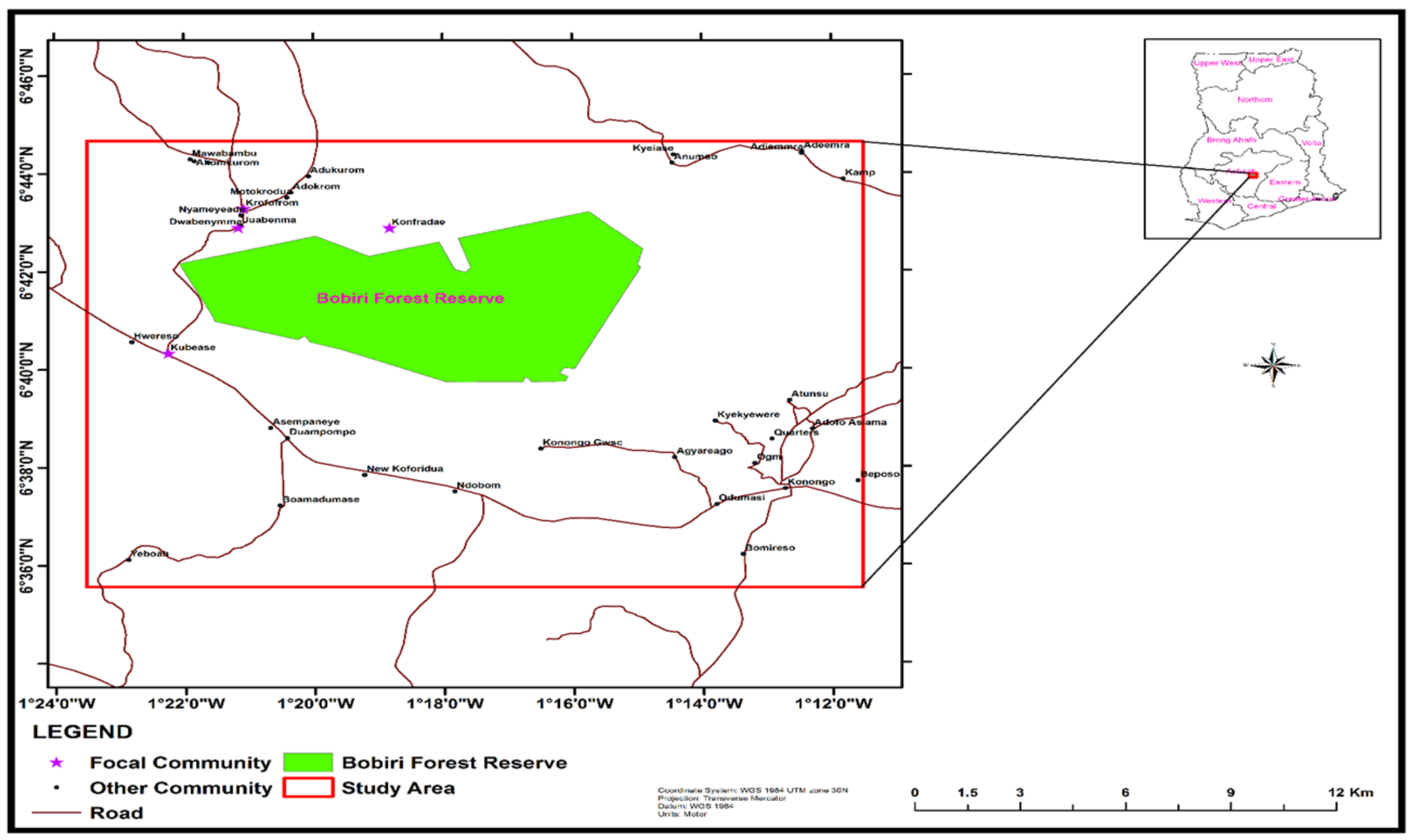
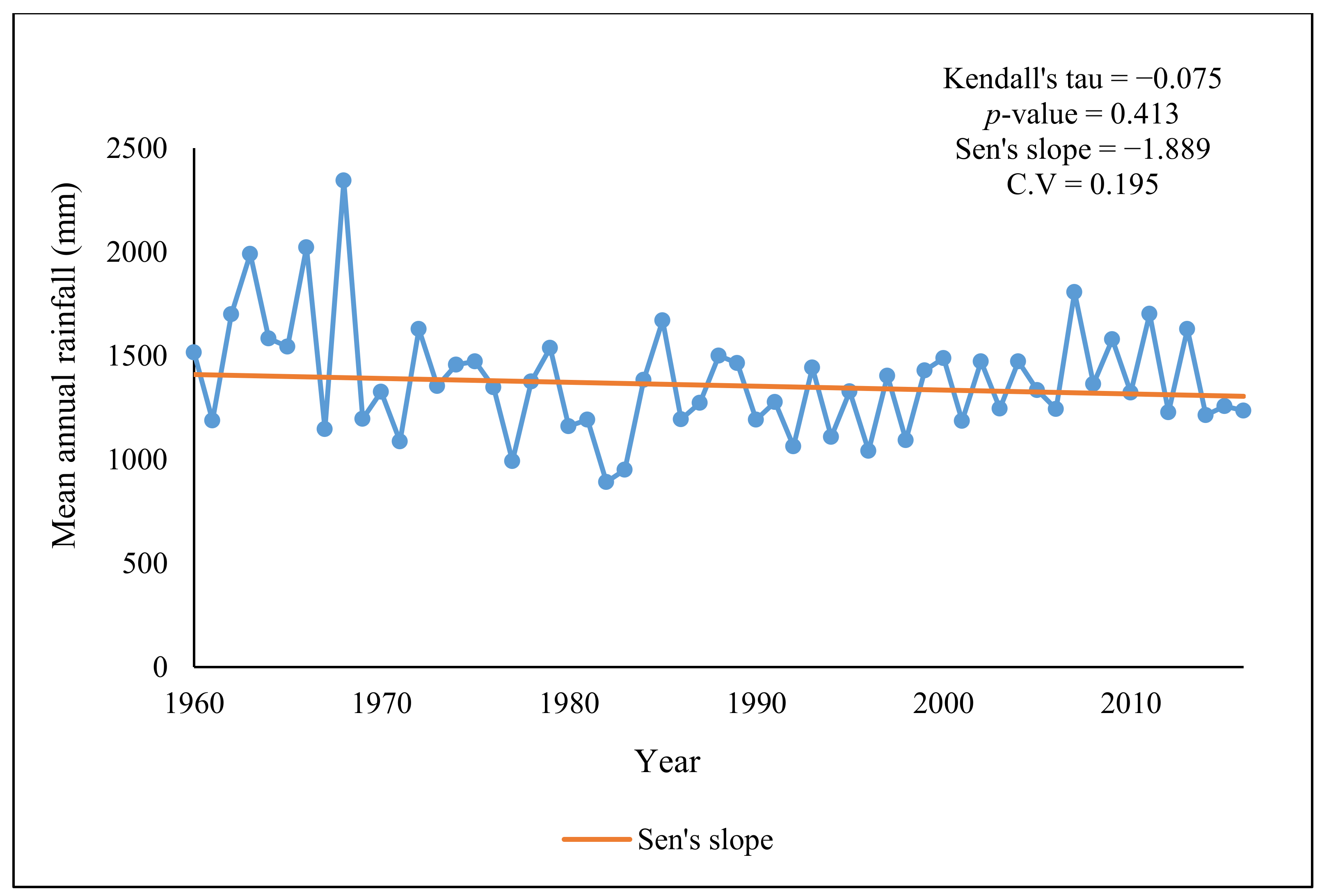

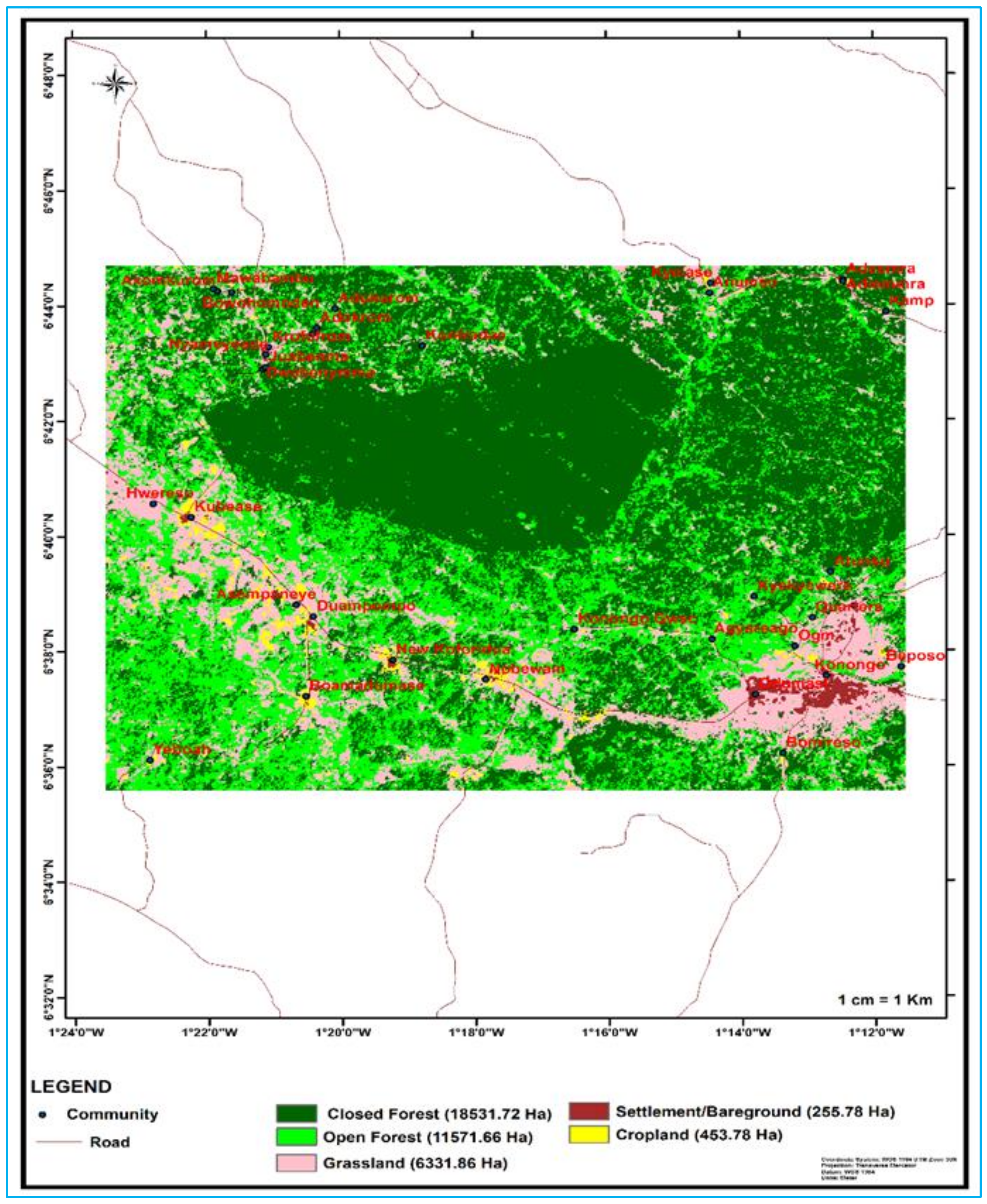
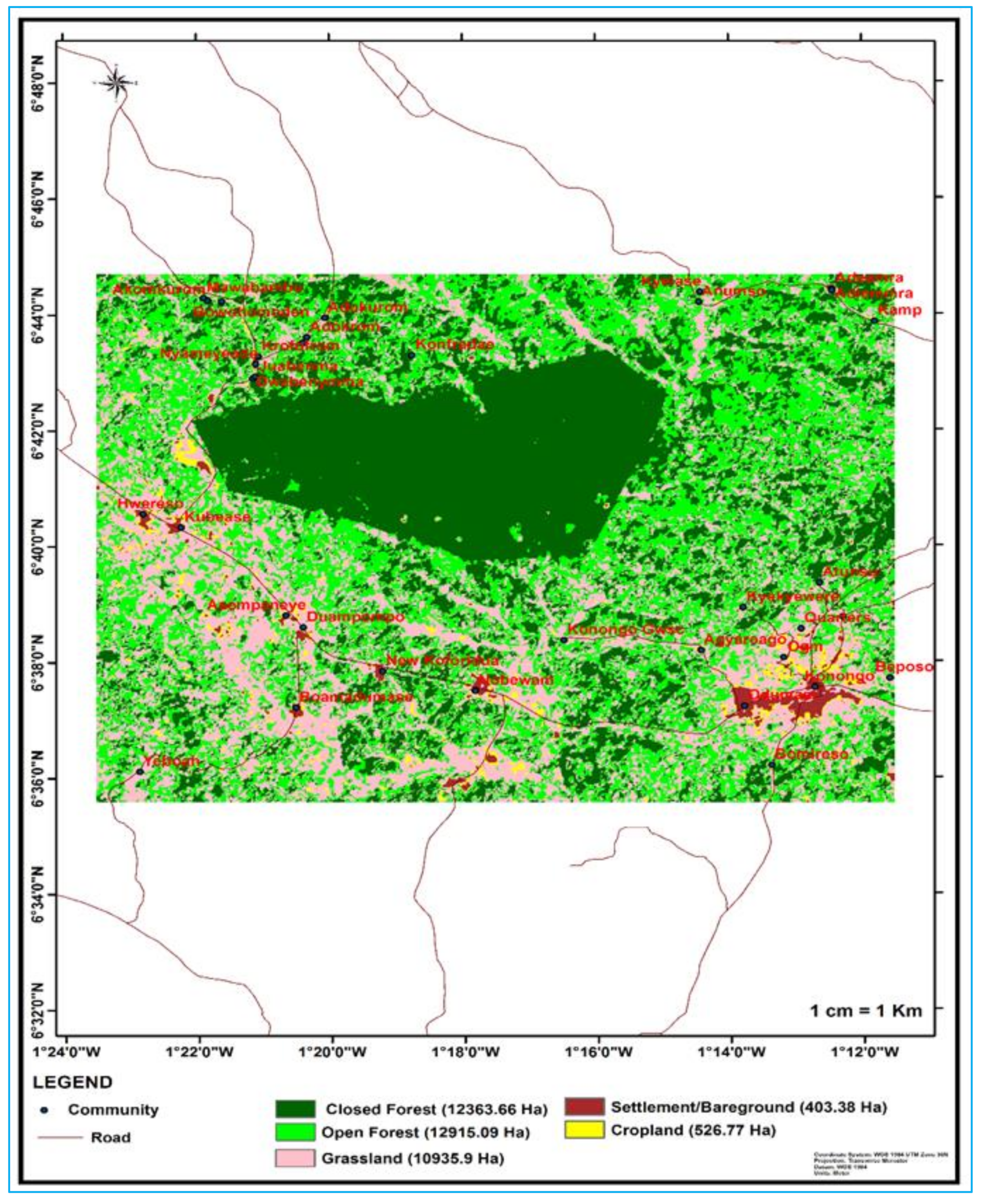
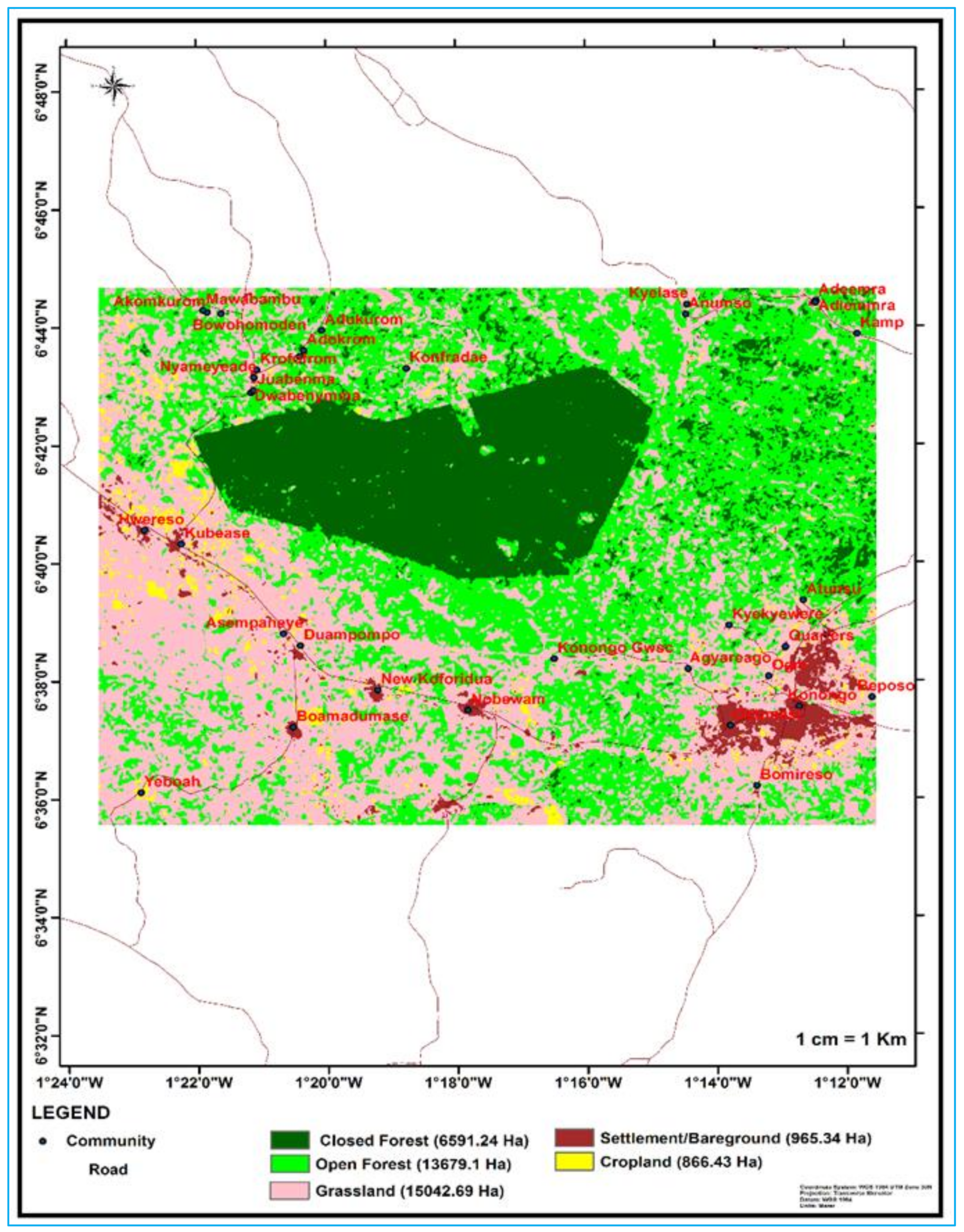
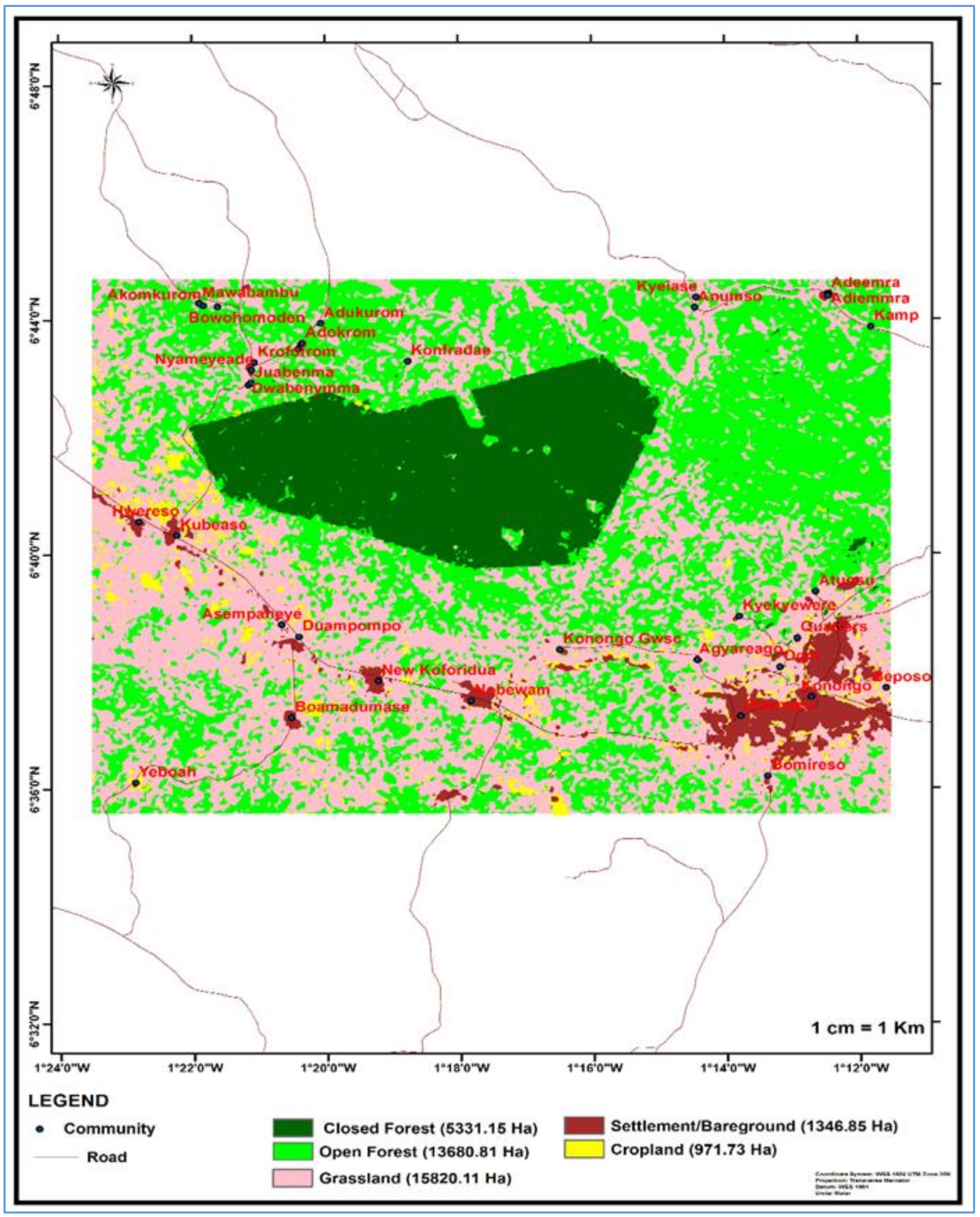
| Community | Distance from the Forest (km) | Main Livelihood Activities | Dominant Tribal Groups | Number of Questionnaires Administered |
|---|---|---|---|---|
| Konfradae | 0.86 | Food crop and tree crop farming | Ashanti | 100 |
| Dwabenymma | 0.90 | Food crop farming | Ashanti | 100 |
| Krofofrom | 1.53 | Food crop farming and poultry/livestock farming | Ashanti | 100 |
| Kubease | 1.82 | Food crop and tree crop farming | Ashanti, Kwahu and Akwapim | 100 |
| Total | 400 |
| Landsat Image | Sensor | Number of Bands | Date |
|---|---|---|---|
| Landsat 5 | Thematic Mapper (TM) | 7 | 1986-01-11 |
| Landsat 7 | Enhance Thematic Mapper Plus (ETM+) | 9 | 2003-02-19 |
| Landsat 7 | Enhance Thematic Mapper Plus (ETM+) | 9 | 2010-02-06 |
| Landsat 8 | Operational Land Imager (OLI) | 11 | 2014-12-26 |
| Land use | Description |
|---|---|
| Closed forest | Areas with timber species and broadleaf hardwoods |
| Open forest | Areas with broadleaf hardwoods |
| Crop land | Perennial crops such as oil palm and annuals such as maize |
| Grassland | Areas with shrubs, grasses and some cases, a few trees |
| Settlement/bare ground | Building, cleared areas and rocky surfaces |
| Livelihood Activity | Gender | Total (n = 400) | |
|---|---|---|---|
| Males (n = 143) | Females (n = 257) | ||
| Crop production | 85 (59.4) | 113 (44.0) | 198 (49.5) |
| Livestock rearing | 24 (16.8) | 33 (12.8) | 57 (14.2) |
| Non-timber forest products | 18 (12.6) | 79 (30.7) | 97 (24.3) |
| Charcoal production | 5 (3.5) | 25 (9.8) | 30 (7.5) |
| Petty trading | 11 (7.7) | 7 (2.7) | 18 (4.5) |
| Variables | Gender | Total (n = 400) | |
|---|---|---|---|
| Males (n = 143) | Females (n = 257) | ||
| (a) Rainfall | |||
| Changes in onset | 111 (77.6) | 179 (69.6) | 290 (72.5) |
| No changes in onset | 32 (22.4) | 78 (30.4) | 110 (27.5) |
| Increasing rainfall | 44 (30.8) | 58 (22.6) | 102 (25.5) |
| Decreasing rainfall | 99 (69.2) | 199 (77.4) | 298(74.5) |
| (b) Temperature | |||
| Increasing temperature | 129 (90.2) | 237 (92.2) | 366 (91.5) |
| Decreasing temperature | 14 (9.8) | 20 (7.8) | 34 (8.5) |
| Perceived Causes of Climate Variability | Gender | ||
|---|---|---|---|
| Males (n = 143) | Females (n = 257) | Total (n = 400) | |
| Overlogging | 75 (52.4) | 182 (70.8) | 257 (64.3) |
| Bush fires | 50 (35.0) | 42 (16.3) | 92 (23.0) |
| Punishment by God | 5 (3.5) | 12 (4.7) | 17 (4.3) |
| Natural occurrence | 10 (7.0) | 14 (5.5) | 24 (6.0) |
| Sign of the end of the world | 3 (2.1) | 7 (2.7) | 10 (2.5) |
| LULC | Area (ha) | ||
|---|---|---|---|
| 1986–2003 | 2003–2010 | 2010–2014 | |
| Closed forest | −6168.06 (−16.6) decrease | −5772.42 (−15.6) decrease | −1260 (−3.3) decrease |
| Open forest | 1343.4 (3.6) increase | 764 (2.0) increase | 1.71 (0.02) increase |
| Grassland | 4604 (12.4) increase | 4106.8 (11.1) increase | 777.4 (2.1) increase |
| Settlement/ bare ground | 147.6 (0.4) increase | 561.9 (1.5) increase | 381.6 (1.0) increase |
| Crop land | 73 (0.2) increase | 339.6 (0.9) increase | 105.3 (0.3) increase |
| Land Use or Land Cover Categories | Years | |||
|---|---|---|---|---|
| 1986 | 2003 | 2010 | 2014 | |
| Area (ha) | Area (ha) | Area (ha) | Area (ha) | |
| Closed forest | 18531.7 (49.9) | 12363.7 (33.3) | 6591.2 (17.7) | 5331.2 (14.4) |
| Open forest | 11571.7 (31.2) | 12915.1 (34.8) | 13679.1 (36.8) | 13675 (36.8) |
| Grassland | 6331.9 (17.0) | 10935.9 (29.4) | 15042.7 (40.5) | 15820.1 (42.6) |
| Settlement/bare ground | 255.8 (0.7) | 403.4 (1.1) | 965.3 (2.6) | 1346.9 (3.6) |
| Crop land | 453.8 (1.2) | 526.8 (1.4) | 866.6 (2.3) | 971.7 (2.6) |
| Total | 37144.9 (100.0) | 37144.9 (100.0) | 37144.9 (100.0) | 37144.9 (100.0) |
| Class Name | Reference Totals | Classified Totals | Number Correct | Producers Accuracy (%) | Users Accuracy (%) | Kappa |
|---|---|---|---|---|---|---|
| Closed forest | 14 | 15 | 14 | 100.0 | 93.3 | 0.9225 |
| Open forest | 27 | 30 | 24 | 88.9 | 80.0 | 0.7260 |
| Grassland | 31 | 30 | 23 | 74.2 | 76.7 | 0.6618 |
| Settlement/bare ground | 14 | 15 | 12 | 85.7 | 80.0 | 0.7674 |
| Crop land | 13 | 10 | 8 | 61.5 | 80.0 | 0.7701 |
| Totals | 99 | 100 | 81 | |||
| Overall classification accuracy = 82.0% | Overall kappa statistics = 0.770 | |||||
| Perceived Drivers of Land Cover Changes | Gender | ||
|---|---|---|---|
| Males (n = 143) | Females (n = 257) | Total (n = 400) | |
| Logging | 88 (61.5) | 105 (40.9) | 193 (48.3) |
| Overgrazing | 5 (3.5) | 32 (12.5) | 37 (9.3) |
| Urbanization | 2 (1.4) | 13 (5.1) | 15 (3.8) |
| Deforestation | 15 (10.5) | 44 (17.1) | 59 (14.8) |
| Infrastructural development | 1 (0.7) | 6 (2.3) | 7 (1.8) |
| Population growth | 32 (22.4) | 57 (22.2) | 89 (22.3) |
Publisher’s Note: MDPI stays neutral with regard to jurisdictional claims in published maps and institutional affiliations. |
© 2021 by the authors. Licensee MDPI, Basel, Switzerland. This article is an open access article distributed under the terms and conditions of the Creative Commons Attribution (CC BY) license (http://creativecommons.org/licenses/by/4.0/).
Share and Cite
Baffour-Ata, F.; Antwi-Agyei, P.; Nkiaka, E. Climate Variability, Land Cover Changes and Livelihoods of Communities on the Fringes of Bobiri Forest Reserve, Ghana. Forests 2021, 12, 278. https://doi.org/10.3390/f12030278
Baffour-Ata F, Antwi-Agyei P, Nkiaka E. Climate Variability, Land Cover Changes and Livelihoods of Communities on the Fringes of Bobiri Forest Reserve, Ghana. Forests. 2021; 12(3):278. https://doi.org/10.3390/f12030278
Chicago/Turabian StyleBaffour-Ata, Frank, Philip Antwi-Agyei, and Elias Nkiaka. 2021. "Climate Variability, Land Cover Changes and Livelihoods of Communities on the Fringes of Bobiri Forest Reserve, Ghana" Forests 12, no. 3: 278. https://doi.org/10.3390/f12030278
APA StyleBaffour-Ata, F., Antwi-Agyei, P., & Nkiaka, E. (2021). Climate Variability, Land Cover Changes and Livelihoods of Communities on the Fringes of Bobiri Forest Reserve, Ghana. Forests, 12(3), 278. https://doi.org/10.3390/f12030278





